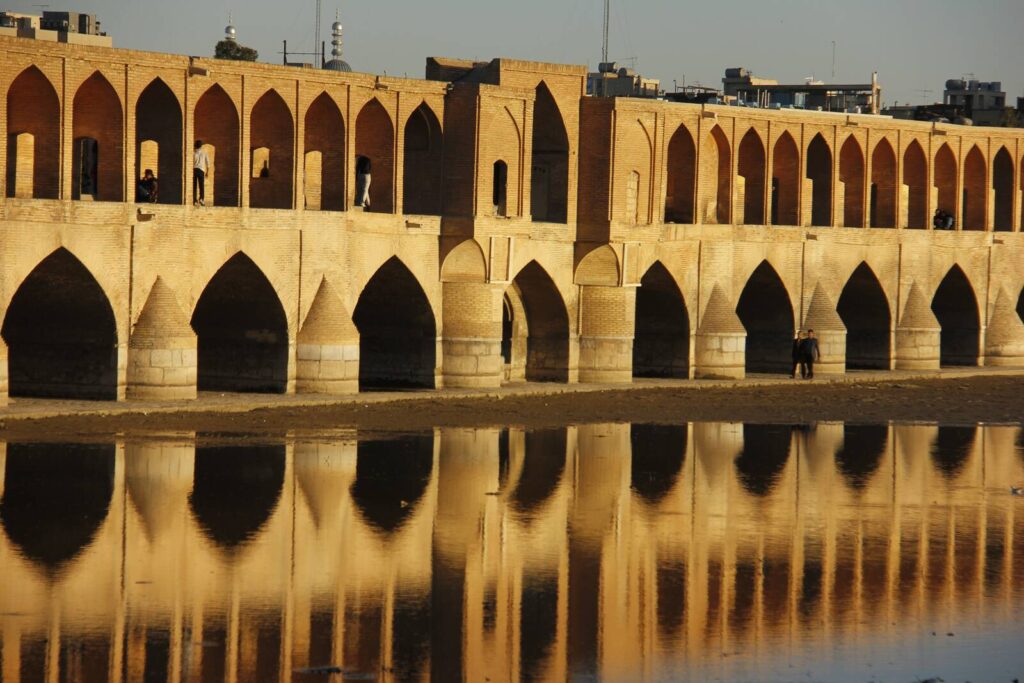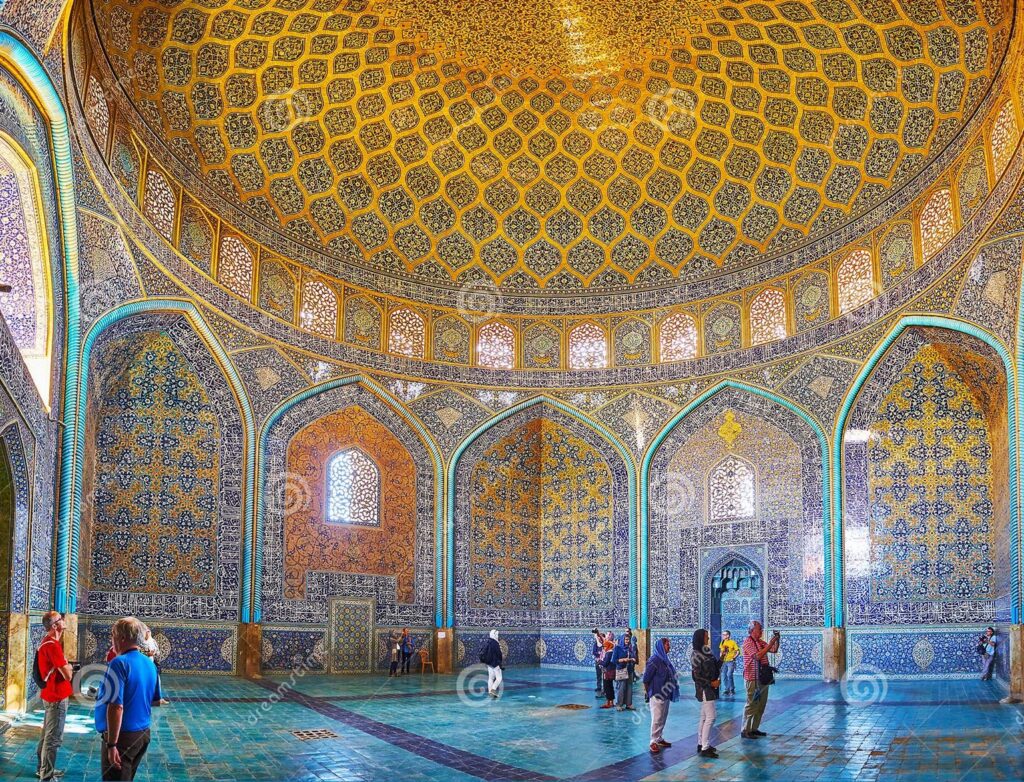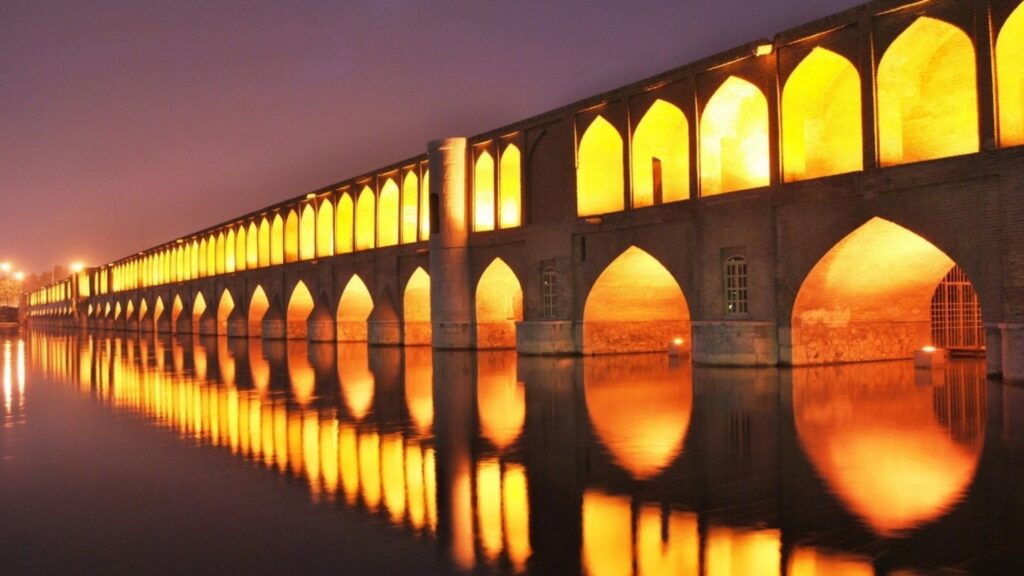
With different historical places, astonishing gardens and parks, and diverse shopping centers, Isfahan is the place for you, no matter what your favorite hobbies are! In fact, this city is called half of the world by the people because they believe that it has the beauties of half of the whole world by itself. There are historical places here that attract thousands of people every year to witness the glory of eastern architecture and culture.
Chehel Sotoun Palace
Chehel Sotoun (literally translated: Forty Columns) is a palace in the middle of Chehel Sotun, meaning “40 columns”, is another surviving Safavid-era palace which now functions as a museum. The twenty slender wooden columns at the front of the palace double in number when reflected in the long fountain (hence the name), and are surrounded by well-maintained gardens. The interior is filled with magnificent frescoes depicting scenes from Safavid court life. Look out for the moustachioed Shah Abbas playing host to a fabulous royal banquet.
Chehel Sotoun is a Persian pavilion in the middle of a park at the far end of a long pool, in Isfahan, Iran, built by Shah Abbas II to be used for his entertainment and receptions.



In the early 17th century, hundreds of thousands of Christian Armenians from northwest Iran were resettled in Esfahan by Shah Abbas – Vank Cathedral is the most impressive of their subsequently constructed places of worship. The outside of the cathedral is fairly plain, yellowy-brown brickwork. By contrast, the inside boasts elaborate and colourful frescoes, containing some disturbing depictions of the terrors of hell. There is also a fascinating museum (which displays Shah Abbas’ original edict establishing the new Armenian town), and a memorial to the Armenian Genocide.
GRAND BAZAR
The main entrance to Esfahan’s Grand Bazaar is along the northern edge of Naqsh-e Jahan Square at what’s called the Qeysarieh Portal (check out the quaint teashop up the stairs to the left). The Bazaar is a higgledy-piggledy collection of alleys, caravanserais, and madrasehs, with light-holes punctuating the domed, high ceilings. Most of the bazaar was developed in Shah Abbas’ 17th–century building frenzy, although some parts are far older. From touristy knick-knacks to the finest Persian carpets, this bazaar has it all.
Naqsh-e Jahan Square
Historical square of Naqsh-e Jahan, currently known as Meidan Emam is one of the Naqsh-e Jahan Square (also known as Imam Square) is the overwhelmingly impressive central attraction of Esfahan, which features a number of architectural wonders. At the southern edge of the square, which stretches over half a kilometre in length, is the Imam Mosque (or Shah Mosque). Completed in 1629, the UNESCO world heritage site is arguably the premier example of Iran’s Islamic architecture. Intricate blue-tiled mosaics, splendid Quranic calligraphy, glittering iwans, towering yet delicate minarets, perfectly geometrical floral motifs – the dazzling aesthetic unity of this structural masterpiece is widely regarded as one of the most beautiful mosques in the world.
Sheikh Lotfollah Mosque
Along the eastern side of Naqsh-e Jahan Square is the no less inspiring Sheikh Lotfollah Mosque. Finished ten years earlier than the more substantive Imam Mosque, Sheikh Lotfollah is notable for its golden-creamy tile work and complex arabesques, not to mention the imposing central dome – mesmerising from both the inside and out. Unusually lacking in minarets, the mosque was originally intended for private use by members of the royal court, and was designed by Sheikh Bahai during the reign of Shah Abbas.
Masjed-e Jame of Isfahan
Known as one of the most important and among the earliest religious buildings in Iran, Masjed-e Jāmé of Isfahan is a magnificent and exquisite, artistically and technically significant monument, which embraces several phases of Islamic architectural development.
The mosque is one of the largest and the most mysterious mosques in the Muslim world in which the main building was developed in early Islamic period, on the basis of a late Sassanid monument.
The current facade of mosque is related to Seljuk era, however, the most important development projects have been conducted under the Safavid and Buyid dynasties.
Masjed-e Jāmé of Isfahan reflects the Byzantium and Classical art in form of a traditional and Islamic building constructed in Razi Persian architectural style with four-Iwan plan.
Different sections of the mosque are: a four-Iwan courtyard, shabestan, Mozaffari school, small terraces of Daylamites era, Nezamolmolk dome, Taj al-Mulk dome, Oljeitu altar (the most beautiful stucco altar), the most beautiful carved pulpit, four famous porches named Saheb, Ostad, Shagerd, Darvish Iwans with muqarnas and Karbandi decoration each presents a certain Islamic architectural tendency. The mosque has multiple entrances linking the inner spaces with nearby contexts. In this exceptional masterpiece, we can see not only different architecture and decoration styles, but also several outstanding inscriptions in Arabic and Farsi calligraphy.
Khaju Bridge (Baba Roknedin Bridge)
Today’s Khaju Bridge was made on the ruins of the past from the late Timurid era by Safavid Shah Abbas II in 1060. This bridge is more famous than any other bridges of the river because of its architecture and tiles decoration.
The Khaju Bridge was one of the most beautiful bridges in the world in the Safavid era largely used as a dam. A building constructed between each of the two eastern and western sides of the bridge including several rooms decorated with paintings.
This building which has been called “Shahneshin” was the place of leaders and kings who came to watch the matches of swimming and boating on an artificial lake.
There are two stone lions in two eastern corners of the bridge that are the symbols of Bakhtiari corps and Isfahan guards in Safavid era.
The bridge has 24 spans made from carefully cut cubes and had been blocked by wooden dams in the middle.
Si-o-Se-Pol
Si-o-Se-Pol, literally meaning thirty-three bridges, is a magnificent and unique structure built over the Zayanderud River. It is also known by the name of its erector, Allah Verdi Khan, who was one of the generalissimos of Safavid dynasty.
The architecture of Si-o-Se-Pol was Master Hossein Bana Esfahani. The genius of this artist can be realized when we are informed that despite all the bridges that have been built in the narrowest part of the river, Master Hossein Bana chose widest part of Zayanderud to build Si-o-Se-Pol. The reason for his decision was that it is the shallowest part of the river, and also provides great views of the surrounding.
During history, many travelers and tourists have adored and admired Si-o-Se-Pol. Some of them are the British writer and geography scientist Percy Sykes, the French traveler Jean Chardin, and the Ambassador of King of Spain Don Garcia. They have all mentioned the many beauties of the bridge in their notes.
It has been recorded in historical texts that during the Safavid era, Si-o-Se-Pol was one of the public locations for holding annual Abrizgan and Abpashan Ceremony on the 13th of Tir, during which people pour water and rose water as a celebration of cleanness and purity.
The importance of Si-o-Se-Pol amongst the other bridges of Zayanderud is in its location, as it connects the famous Chaharbagh Street on the two sides of the river. It is said that the bridge was three hundred and sixty meters long when it was first built, and it had forty vaults. Today Si-o-Se-Pol is two hundred and ninety-five meters long and has thirty-three vaults, which is the reason for its name. However, it is still the longest bridge built over Zayanderud.
One can easily walk onto the bridge. As one walks over the bridge, he can enjoy the view of the river and its surrounding. In the past, there used to be two parallel grooves along the bridge that separated the path for pedestrians from the one intended for the carriages and the cattle.
The materials used in the structure of the bridge include stone, brick, mortar of Sarooj and plaster. The combination of these materials adds to the durability and strength of the bridge. However, the drought of recent years has led to concerns about the condition of the piers of the bridge.
In a trip to Isfahan, visiting Si-o-Se-Pol during night time, when it is beautifully lighted, should not be missed.
Borujerdis’ Historical House
Borujerdis historical house is one of the aristocratic houses in Qajar period, built by a famous merchant of Kashan whose name was Haj Seyed Hassan Natanzi.
This building generally consists of two outer and inner parts without garden. Contrary to the conventional beliefs, this house didn’t belong to the people of Borujerd but because of the trade between Natanz merchants who were originally from Kashan with Borujerd merchants, Kashan people called it Boroujerdi.
Most of the characteristics of old house in Kashan including two basements around the inside and outside yards, a roofed place, panjdari, Mahtabi, entrance porch, a summer porch, winter porch etc., have found in this house architecture adequately appropriate designed to the climatic characteristics and weather conditions of desert area in three floors.
The roofed place in this house is the most exceptional character in entire city. Borujerdis house is one the important historical monuments in terms of architecture, painting and stucco decorations as well as its antiquity. Today, the exterior part of building is belonged to Cultural Heritage Organization from 1353 Hijri and the inner parts are under private ownership.
MAJESTIC PALACE
Hasht Behesht Palace of Isfahan is one of the most spectacular historical places in this city that makes everyone admire it from the very first moment. The architecture of the palace is interesting and in the form of a plateau and has a porch facing north. On the first floor, wherever you look, you can see very beautiful and unique plastering. When you go to the second floor of this mansion, the rooms and arches show themselves and on this floor, you can see several rooms and corridors. In each of these rooms, a special type of decoration attracts attention. The art of mirror work has been used to decorate the walls. Generally, the decoration of Hasht Behesht Palace in Isfahan is amazingly magnificent and has always been of interest to tourists, especially foreign tourists. Hasht Behesht palace, which is surrounded by Hasht Behesht garden, is an enjoyable place to visit, and many families spend their time in this garden to stay away from the amenities and technologies available in their homes.
Ali Qapu
Ali Qapu is one of the four main buildings of the Naqsh-e Jahan Square in Isfahan, each positioned in one of the borders surrounding the square. It differs from the other three constructions. Ali Qapu is neither a mosque nor the gateway of a bazaar, instead it is a large Iwan (porch) with columns, from which the Safavid king would observe and enjoy the polo games taking place in the Naqsh-e Jahan Square.
This building was made during the Shah Abbas Safavid era, to host the meetings that Shah held with the high ranking guests and foreign ambassadors.
Today one has to go to the south after entering the square, but in the Safavid era the Ali Qapu served as the Grand Gate to the square.
Today the image of Ali Qapu represents the beauty and grace of the eastern aesthetics on one hand and the westerns emblems and elements on the other. At the beginning Ali Qapu was not built in its current form, the initial building was only the entrance gate to the Safavid governmental offices, and it was a simple building. Throughout different eras and especially during Shah Abbas period different stories were added. The columned Iwan of the Ali Qapu building is the legacy of the Shah Abbas the Second.
This forty-eight meter building is composed of six stories that a narrow and tiled staircase connects them to one another. The ground floor is composed of two halls that were dedicated to the official and court affairs of the Safavid government.
One of the most awe-inspiring parts of the Ali Qapu building is the Music Hall or the Sound Hall. The walls of this room are adorned by unique niches in forms of urns that in addition to their visual beauty had the function of beautifully echoing the sound of the instruments that were played in the room.
The large terrace of the Ali Qapu is built on the third floor. It is a large terrace with eighteen columns that hold a ceiling covered with paintings on wood. There is a water pool in the middle of the terrace that its mirror form is visible on the ceiling, reflecting the image of the entire square.
The stairways of the building are covered with tiles and going through the staircases one has the sensation of walking upon and through an elegant carpet.
One of the most well-known artworks of the Ali Qapu is a wooden door that is said to has been brought in from Najaf, Imam Ali holy shrine. The relief at the top of the door reads “I am the city of knowledge and Ali is its gateway” and reiterates the probability of this premise.










